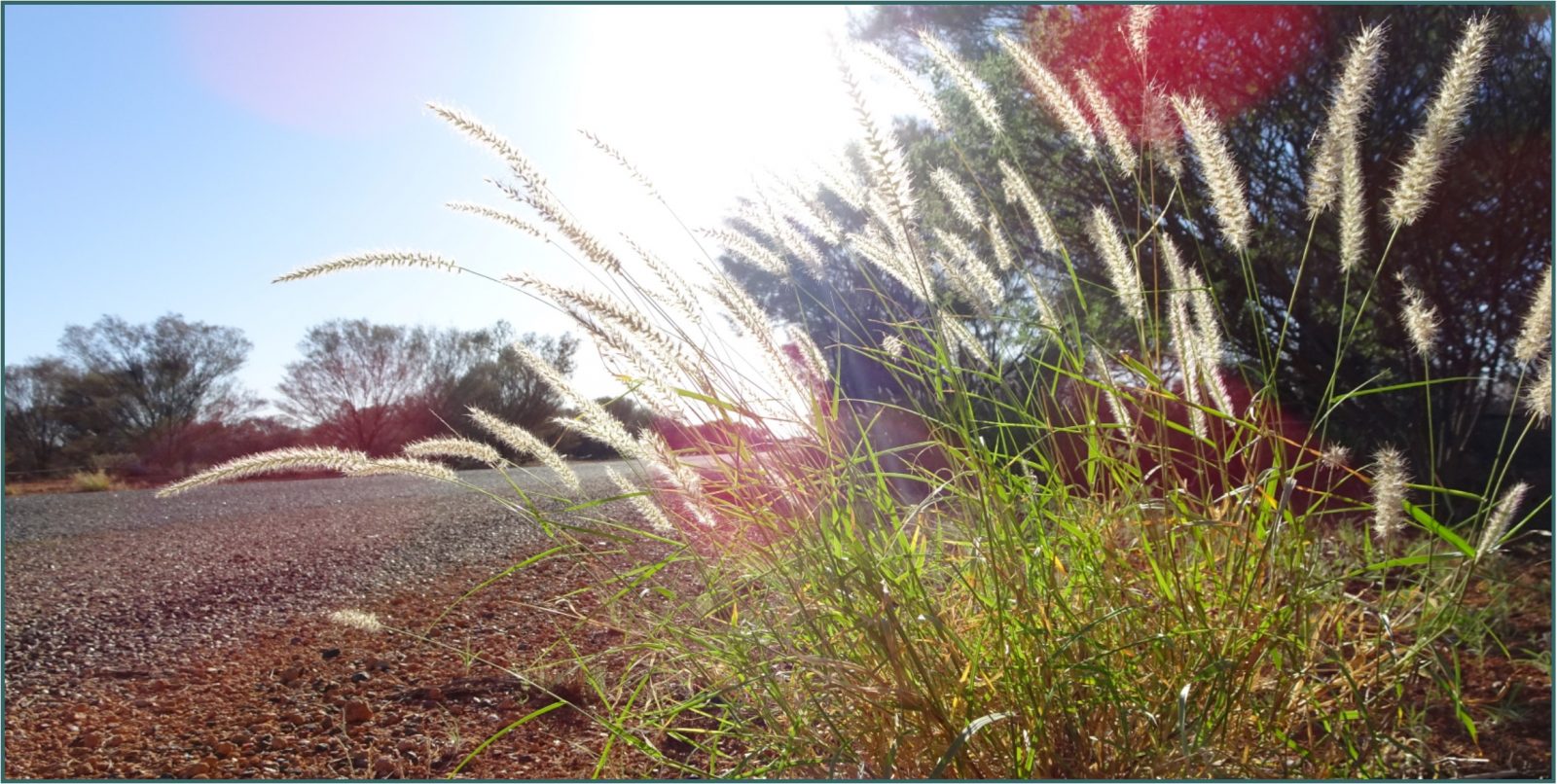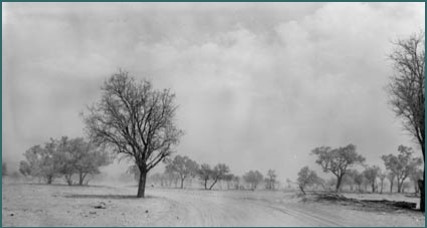
By Des Nelson
Having recently heard the sometimes repeated view that CSIRO was responsible for the invasion of Buffel Grass in central Australia, I would like to present some observations of my own. I do not write of hearsay. I had first-hand experience of all places and events here described.
In the early 1950’s I observed a fairly large stand of small black-headed Buffel Grass near Barrow Creek. This strain also occurred patchily along the banks of the Todd River. It was a minor part of the vegetation. I believe this may have been the Buffel historically accepted as having been introduced during the era of camel transport in the 19th century, either accidentally from studding from worn saddles, or deliberately planted. It is hard to find these days.
After World War 2, the cattle industry was deemed to be of maximum importance to the prosperity of central Australia. Much effort was expended to improve it. Pasture improvement was one category to be promoted. Some cattle stations were provided with bulk quantities of Buffel Grass seed, I believe by the Federal Government, before any works by CSIRO or other departments were developed. In the workshop of a station on which I was a teenage jackaroo in the early 1950’s, was a room full of chaff-bags of such Buffel seed. When I did a bore run I carried a bag of seed in my truck and threw out hands-full as I drove. A primitive methods but it did work to a minor degree.
Before CISRO arrived on the local scene, two Browns sowed Buffel on their properties in the 1950-1951 seasons. Burge Brown on Murray Downs, 400 Km NE of Alice Springs and Jim Brown on White Gums near Honeymoon Gap.
CSIRO was established on a permanent basis in Alice Springs with the arrival of Bob Winkworth in 1953. ‘Winky’ travelled widely in the district learning the country, meeting the people and studying the flora and hydrology of the region. Later he established study sites in the bush and began work on a small paddock on the Arid Zone Research property, commonly known then as the Animal Industry Branch, or AIB Farm. Here, small plots of proposed pasture plants were sown, among them strains of Buffel. The work began in 1960, by which time we were into the third year of a terrible drought. The little plots had to be irrigated to survive. In 1958, the first year of the eight year drought, a small exclosure had been built just south of the Alice Springs Airport. Here deep ripping had been done on a clay-pan and Buffel seed sown into the deep trenches. Known as the ‘Scald Site’, the drought ensured it would fail.

Local conditions became very grim as the drought progressed. Much of the countryside was completely denuded of ground cover in the pastoral areas. On field trips I found it better to travel into sand-dune desert country which was free of dust, while Alice Springs was enduring massive, towering dust storms. Cattle were starving and dying. Turboprop and pure jet passenger aircraft had replaced piston engine craft by this time. Their engines were more sensitive to the effects of dust-laden air.
Two schemes were promoted by officers of the Northern Territory Government. One was to establish some pasture to enable the cattle industry to survive. The other was to eliminate dust for the airline industry to survive.
Now came a period of great activity. A dust exclusion zone was declared, mainly to the south of Alice Springs; then came a large-scale planting of Buffel Grass, not just on the dust exclusion zone but on many of the centre cattle stations. Two tractor towed machines were used, the Paech pitter and the opposed disc plough. Clay-pan areas were ploughed and planted in a spiral pattern, visible clearly from the air today.
To assist these programs a variety trial was established by the NT Government in the Quarantine paddock, SW of Alice Springs. There, in the 1970’s, six strains of Buffel plus Birdwood Grass were extensively planted in rows, four runs for each strain. When the grasses had become well established, cattle were released into the area, enabling observation as to which of the grasses were preferred for grazing. The seed of the three most preferred strains were used in planting many thousand hectares of pastoral country. There is speculation that a specific central Australian strain of Buffel Grass originated from trial plantings of adjacent strains. The extensive plantings in the Quarantine paddock would be the most likely place of origin of such a strain.
The mechanical sowing of Buffel by the Land Conservation Unit of the Conservation Commission of the NT was a huge success and without doubt, along with a series of above average rainfall years, has given us the Buffel landscape we have today.
Part of the success of Buffel may be due to the fact that plant breeders have produced strains that are specifically Australian. There are many Australian developments such as the Kelpie and Blue Heeler Dog; there are Australian Cattle breeds; the renowned Waler Horse; Australian Chooks; Federation Wheat, and so on. So, with Buffel we have strains like Biloela, Gayndah, West Australian and others.
It is hard to describe to those who did not experience it, the conditions present during the 1958-65 drought. Thousands of kilometres of utterly bare ground. Every breeze blew dust. Colossal dust storms reduced visibility to nil. I did much field work during this period. One morning I awoke to find my swag half buried in drift. On another occasion I drove to a photo site 80 km SE of town to find a fence there had been buried by moving sand. To the north of town I spoke to a station manager whose job then was to drive around, shooting cattle which were too weak to walk. I never imagined beasts would become so thin, looking almost like cardboard cut-outs. You could push them over from the side. They were too weak to rise again.
No wonder that the belief that some saving pasture could remedy things was so widespread. Buffel Grass was believed by pastoralists and scientists to be the answer. If some of those who are here today were living during those devastating conditions, they would have agreed. Only one professional person in my memory spoke against the sowing of Buffel. When asked what he thought about it, botanist George Chippendale said, “I don’t think it is a good idea”.
Reclamation work took place in selected areas during the drought. One such place was the former Simpsons Gap Station. Limited area, rugged terrain, limited pasture, grazing livestock and Rabbits reacted together to leave the place denuded and eroded by wind and water. CSIRO helped with the earthworks, and Buffel seed was sown. South of Simpsons Gap, White Gums Station also suffered, but careful management had kept the landscape in a less eroded state. The Yeoman’s Keyline system was employed to promote pasture growth that included Buffel Grass. Much of the effort was frustrated by Rabbit grazing. We had a serious problem with Rabbits in some places in the centre, contributing to vegetation damage. Rabbits contributed greatly to the removal of ground cover at Uluru. The gorges around the Rock were bared. Conservation Commission got to work with its machinery sowing Mutitjulu Gorge with Buffel, with eventual spectacular success.

Although it was hoped that Buffel Grass would come a useful part of the ground vegetation, few realised that it would reach its current dominance, particularly on hillsides, alluvial, and calcareous soils. My personal opinion of Buffel is ambivalent. If I were a pastoralist I am sure I would encourage it. Otherwise, I am saddened by the effect on places where it is so dominant that it is a serious fire hazard and has eliminated large areas of wildflowers. In my sixty-five years of bush observations in the centre, 1967-68 was the time of most profuse and widespread growth of wildflowers. With the covering of Buffel, such a display will not occur to the same extent. Tests with a radiometer were made in the rural residential area just south-east of Alice Springs in 1990. These showed that shading of the ground under Buffel tussocks was about equivalent to that of night time, effectively reducing the chances of other species competing for light, as well as nutrients.
Buffel Grass is here to stay. It is not my intention to discuss here what means can be used in its control but I do have opinions. I will mention that by sheer hard work, personnel at the Alice Springs Desert Park have done a wonderful job at eliminating Buffel from their domain. If you want to see a piece of local country looking as it should, have a look at the Desert Park landscape. How ironic is it that the work done there was performed by the Parks and Wildlife Commission of the NT, the direct descendant of Conservation Commission of the NT whose Land Conservation unit was largely responsible for the very successful spread of Buffel Grass in central Australia.
It can be seen that the part played by CSIRO for the Buffel Grass invasion was not the major one by a long shot.
~ Des Nelson OAM
Alice Springs 23/4/2018
Addition:
Des has expanded on this story with his next article, Ecological Observations. Read the article here.
Categories:
Biodiversity, Plants, Weeds